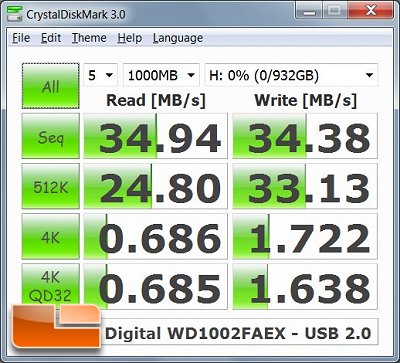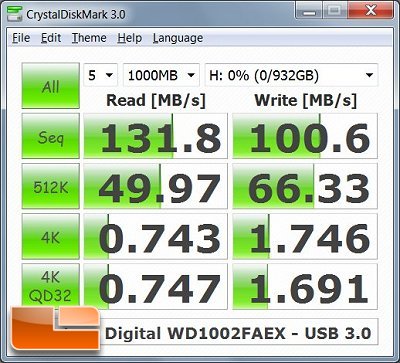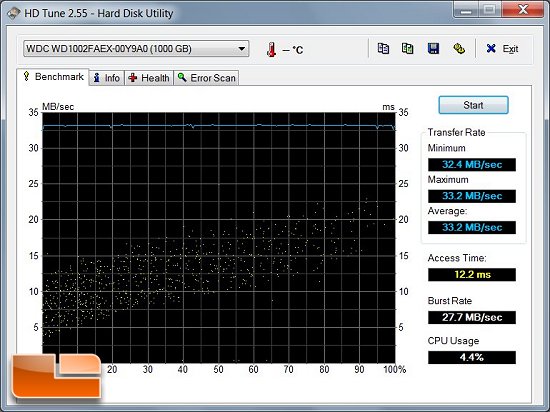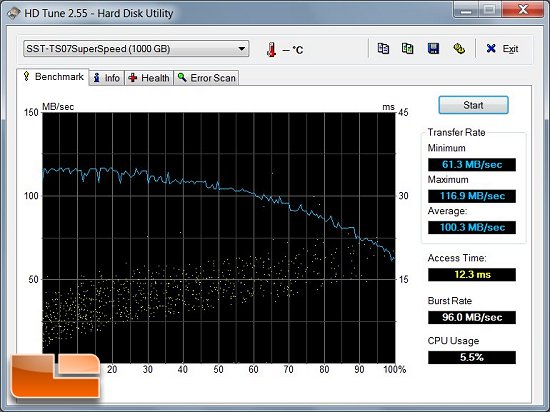SilverStone SST-TS07B External USB 3.0 HDD Enclosure Review
Benchmarking the SilverStone SST-TS07B
CrystalDiskMark
CrystalDiskMark is a program which allows enthusiasts to get a closer look at their sequential and random read/write speeds of their storage devices. We’ll do a side-by-side comparison of USB 2.0 and USB 3.0 performance using the SST-TS07B in both tests.
1000MB Files Test – USB 2.0 Benchmark of the SST-TS07B using the WD1002FAEX:

Definitely not winning any performance speed records, the USB 2.0 specification is woefully inadequate in handling today’s large capacity and high performing storage devices such as SSDs. Maximum sequential read and write speeds were a mere 34MB/s, and we can infer that our WD1002FAEX hard drive is completely saturating the throughput offered by USB 2.0.
1000MB Files Test – USB 3.0 Benchmark of the SST-TS07B using the WD1002FAEX:

Things are looking very good for the SilverStone SST-TS07B using SuperSpeed USB 3.0. Benchmark results show that read and write speeds have increased significantly: sequential read speeds have increased from 34MB/s to 131MB/s and write speeds also show marked improvement, from 34MB/s to 100MB/s.
HD Tune
HD Tune is a program which gives enthusiasts a graphical representation of the minimum, maximum and average transfer speeds of their storage devices. We’ll do a side-by-side comparison of USB 2.0 and USB 3.0 performance using the SST-TS07B in both tests..
USB 2.0 Benchmark of the SST-TS07B using the WD1002FAEX:

Here we can see just how poorly USB 2.0 is able to accommodate the speeds of large capacity, high throughput storage devices. The flat line seen above might as well represent the heartbeat of the USB 2.0 specification as it clearly does not have a future where demand for faster access to our data is needed. With an average transfer rate of 33MB/s, we can see that it is the USB 2.0 specification that is holding back the SST-TS07B, not the external enclosure.
USB 3.0 Benchmark of the SST-TS07B using the WD1002FAEX:

With a much higher throughput versus USB 2.0, SuperSpeed USB 3.0 via the SST-TS07B clearly demonstrates that it is up to the task of providing the necessary throughput to support large capacity hard drives and SSDs. Average transfer rates are just over 100MB/s, a far cry of the rather pitiful 33MB/s rate that USB 2.0 delivered. Burst rates, too, are greatly improved, with the SST-TS07B posting 96MB/s, while with USB 2.0, you’re lucky if you even hit 30MB/s.
It’s important to note that the performance of the SST-TS07B (and really, any external enclosure for that matter) using the USB 2.0 specification is expected to be rather uninspiring. With the WD1002FAEX capped by the limitations presented by USB 2.0, performance suffers tremendously. However, allow the WD1002FAEX to run free with USB 3.0, and the performance of the SST-TS07B improves significantly, as it should..
With benchmarking completed, it is easy to see that the SST-TS07B is really well-suited for the USB 3.0 specification when it comes to data transferring duties. Although USB 2.0 will work in a pinch, transferring large volumes of data, perhaps a terabyte or two, and you might as well make a cup of coffee and catch the latest on G4. The SilverStone SST-TS07B was designed from the ground up to be a tool-less, USB 3.0 capable external hard drive, and it delivers on all fronts.

Comments are closed.